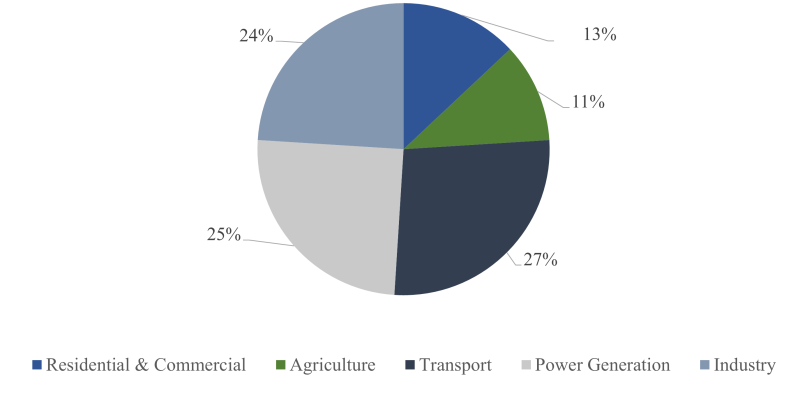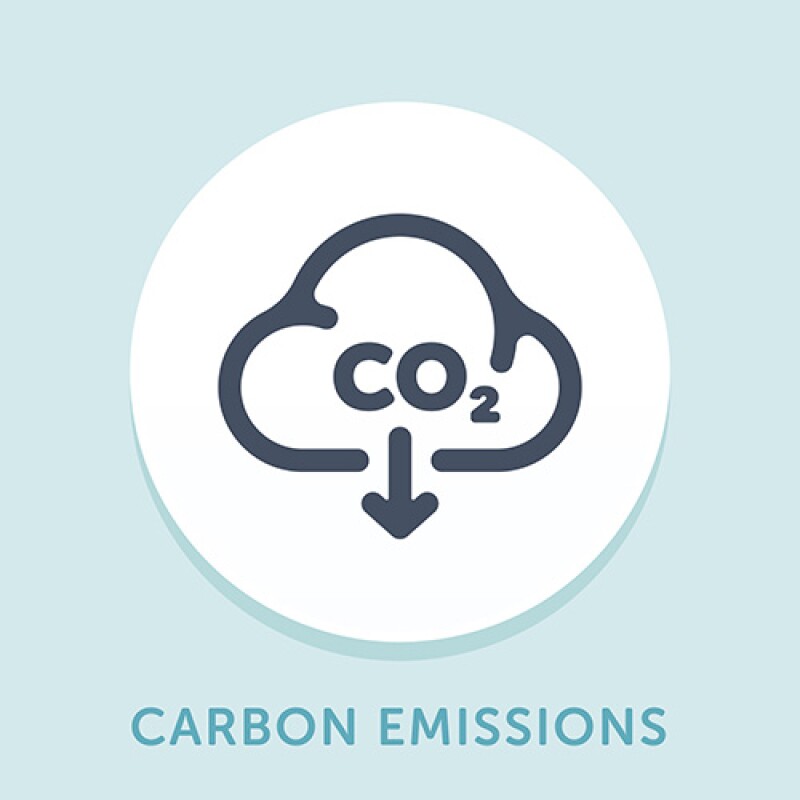Energy Demand Continues to Grow—So Too Will Carbon Emissions
Over the last hundred years, global energy demand has risen 10-fold. This massive growth has been fueled almost exclusively by coal, oil, and natural gas and fossil fuels comprise 80% of today’s energy supply (Fig. 1). To date, low- or zero-carbon energy from nuclear, solar, and wind remains a small but growing fraction of the global energy mix. Global carbon capture, utilization, and storage (CCUS) projects are being developed, but existing capacity is three orders of magnitude lower than current emissions levels. The number of projects will need to rise substantially to help offset emissions from fossil fuels used to sustain economies around the world.

Energy demand is expected to grow substantially, along with carbon emissions (Fig. 2). Much of that growth is expected to come from outside the developed world, which includes the countries in the Organization for Economic Co-operation and Development (OECD). Most incremental future demand will come from places in the developing world such as India where rapid economic growth has translated into substantial energy consumption, including large volumes of coal.
Reducing poverty and promoting continued economic growth is critical for many of these countries, and thus slowing their demand for energy is not a viable option. That poses a challenge to the United Nation’s two-degree Celsius climate change target set out in the Paris agreement, which could require net-zero emissions globally by the second half of the century (Equinor 2021).

The US Illustrates the Carbon-Cutting Challenge
There are multiple means to substantially reduce carbon emissions. For example, countries like the US and India have installed large amounts of solar and wind as an alternative to natural-gas- and coal-fired power generation. Additionally, new process heating technologies combined with low-carbon energy could reduce heavy industry emissions through electrification (Wei et al. 2019).
However, these carbon-cutting strategies are not without complications. First, deep decarbonization will require massive investment in infrastructure that could face substantial regulatory barriers (Hsu & Ulama 2020). Second, electrification may prove uneconomic in many circumstances (Deason et al. 2018). Third, carbon emissions from agricultural sources such as livestock will be hard to abate. Lastly, a large source of energy demand is for transport, which has proven resistant to decarbonization despite increased availability of battery-operated electric vehicles. Currently only 1% of cars on the road in the US are electric. Roughly 62% of US carbon emissions come from hard to abate sectors (Fig. 3).

Subsequently, the US will likely struggle to substantially reduce emissions further because much of the progress has been driven by the widespread availability of low-cost natural gas displacing coal. Decarbonization will be even more difficult in the developing world where energy demand continues to grow and affordable, lower-carbon energy is harder to find. This is no small problem. In India, 60% of carbon emissions are expected to come from coal even in 2050 (EIA 2021).
We Need Carbon Capture at Scale
If cutting emissions upfront is challenging, CCUS could prove essential to offset carbon from hard-to-abate sectors. For carbon capture to take off, there will need to be a reduction in technology costs and increased incentives to invest in these projects. However, not all technologies are the same and each will need to be addressed on their own merits (Fig. 4).

Some such as CO2 enhanced oil recovery (EOR) are already commercially viable. The key challenge for EOR projects is to use captured rather than produced carbon dioxide which will require more infrastructure investment. Those investments are supported in some regions like the US by tax credits (Jones & Sherlock 2021). Projects today like the Petra Nova power plant near Houston, Texas only captured a portion of its emission but we could see substantially all emitted carbon from future projects captured and injected if technology improves and financial incentives are in place. More impactful will be if carbon capture in other high-emitting industries such as steel and cement manufacturing can be commercialized for EOR purposes.
Another exciting technology—direct air capture (DAC)—could conceivably provide net-negative carbon emissions at scale. The biggest challenge for DAC is its relative immaturity. It is projected to comprise less than 2% of CCUS additions by 2030. While there are almost 20 facilities currently, each are small scale prototypes with limited capacity (IEA 2022). Scaling up DAC will likely require substantial government support through direct research and development spend and tax credits for novel CCUS technologies. Fortunately, more than a dozen programs in OECD countries such as Canada, Europe, the US, and Japan provide funding to DAC projects (ibid.). Private companies such as Google, Facebook, and Stripe are also pledging funding through market commitments for future technologies. Developing revenue opportunities from captured carbon beyond EOR or underground storage could incentivize more widespread development in the long term.
Towards a Lower-Carbon Future
Reducing energy poverty and boosting economic growth is critical to supporting human welfare across the developing world. At the same time, most energy consumed today comes from coal, oil, and natural gas that emit large amounts of carbon. Without a massive shift in the deployment of renewables and other low-to-zero-carbon energy sources, the world will continue to rely on fossil fuels to keep the lights on. Moreover, there are many hard-to-abate sectors including transport and agriculture where there are limited low-emission alternatives.
If countries intend to limit global warming based on the Paris Agreement targets, CCUS will be needed to supplement reductions in direct emissions. While most carbon capture technologies are in their early stages, support from government and industry should drive deployment of net-carbon-negative CCUS projects over the coming decades.
References
Jones, J. & Sherlock, M. 2021. Congressional Research Service (CRS), The Tax Credit for Carbon Sequestration (Section 45Q).
Deason et al. 2018. Electrification of Buildings and Industry in the United States, Lawrence Berkeley National Laboratory.
Equinor. 2021. Energy Perspectives.
Hsu, D. & Ulama, D. 2020. Building the Energy Infrastructure Necessary for Deep Decarbonization Throughout the United States, MIT Center for Energy and Environmental Policy Research.
International Energy Agency (IEA). 2022. Direct Air Capture: A Key Technology for Net Zero.
US Energy Information Administration (EIA). 2021. International Energy Outlook 2021.
Wei, M. et al. 2019. Electrification of Industry: Potential, Challenges and Outlook, Current Sustainable/Renewable Energy Reports.


